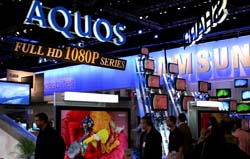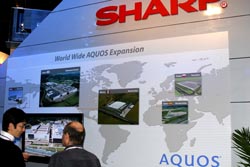Chasing the Consumer Juggernaut

- "The biggest LCD panel in the world" may sound like irrelevant marketing hype at a consumer show like CES, but the fact is that the economies of scale being realized by the opening of Gen8 LCD plants like the new Sharp plant in Kameyama, Japan mean that LCD is poised to grab market share from Plasma at an unprecedented rate.The 2007 Consumer Electronics Show in Las Vegas is now history and as usual we saw any number of new and exciting developments in the world of display technologies for the consumer side of the market. In recent years the CES Show has become the harbinger of things to come in the commercial audio visual/rental and staging industries and this year we saw the introduction of an entire new generation of Plasma and LCD flat panel displays. The buzz at CES was all about 1080P flat panels with increased contrast, more brightness with new light sources, and faster response times. But before we run out and invest in the latest and greatest, we need to ask ourselves: is 1080P necessary or even useful in the rental & staging world? Are these new developments actual benefits or merely features to feed the engine of some manufacturer's marketing hype. Let's take a look at the latest advancements in flat panels, and a look at whether their rapid evolution has bearing in the staging business.
- The first thing to understand is that the flat panel display industry as a whole is in turmoil from an over supply and market price perspective. A year ago, a 42 inch plasma display from major manufacturers was in the $2,000 price range and a 40 inch LCD display was just under $3,000. Over this holiday season, the very same major brand plasma now sells for $1250 and the similarly sized LCD sells for $1600. The off-brand products out there go for under $1000 for plasmas and not much more for a 40 inch LCD display. In a recent speech the president of Sony noted that he was shocked at the rapid decline in pricing on flat panel displays over such a short period of time. The answer from the manufacturers to the dilemma of declining prices and profits is to offer higher performance displays with more features at higher prices and then the channel can "sell up" to their more high performance (more profitable) models. It then becomes the task of the marketing departments to convince the buying public that they need the pricier displays. The question to be asked from the rental and staging perspective, is the price worth it?
- Let's tackle the issue of flat panel resolution. In plasma displays we see 42 inch panels with 852x480 native resolutions and a step up to 1024x768 for premium models. This was an attempt on the part of plasma panel manufacturers' to stem the tide of lower prices for their entry-level models.
- In the larger 50 inch size the panels are typically 1366x768. As noted above, new 50 inch and larger plasmas will offer a full 1920x1080 panel to replicate pixel by pixel the highest standard for full HD resolution. At this point 1080P plasma displays are available in sizes of 50 inch, 65 inch, 71 inch and a huge 103 inch model. It does not appear likely that the plasma guys will be offering sub 50 inch displays at 1080P leaving this niche to the LSD advocates.
- In the land of LCD, we typically have 40 inch panels at 1366 x768. Panel sizes 42 inch and above are typically 1920x1080. Some manufacturers are addressing the declining price issues by having both a 1366x768 and a 1920x1080 option for their 40 inch, 42 inch, and 46 inch displays but all LCD monitors 46/47 inch, 52 inch, 57 inch 65 inch and the recently announced 108 inch are the new 1920 x 1080 panels.
- The trend to 1080P is interesting but it begs the question as to whether audience members at staged events or meetings sit close enough to the screen or viewing material to necessitate 1080P resolution in plasma or LCD and the correspondingly higher prices for those displays? In the not too distant past, we were content looking at images with 240 lines of resolution.
We then "graduated" to images at 480 lines of resolution. Without fear of contradiction, this was a major improvement in visual acuity at all viewing distances but to go to higher resolutions when the viewer is seated more than eight feet from the screen, clearly provides diminishing returns on the investment in higher resolution displays. Nowhere is this better understood than when we look at the true HD standards of 720P and 1080P. If we sit in front of a flat panel display with a 1366x768 native resolution and compare it side by side with a 1920x1080P display, all things being equal, we can tell a substantial difference-2 feet away from the display! If we move back to 6/8 feet from the display or farther, it is more difficult to see the difference between an 852x480 display, a 1024x768 display, a 1366 x 768 display or a 1920x1080 display. More pointedly, at the 20-100 feet and more distance that audience members of a staged event or meeting are from the screen, suffice it to say the hi-res becomes a moot point. The major television and cable networks are still at war over the broadcast side of digital television with one camp saying that 720P is more than good enough and the other saying that 1080P is the best solution. The one thing we know for sure is that you cannot break the laws of physics and when we measure what the human eye can resolve at certain distances, the argument for 1080P for most rental and staging applications is hard to justify.

It's clear that in recent years the very strong momentum of consumer electronics-particularly HD television and HD content-have changed the direction of the arrow of influence between development of consumer products and development of commercial AV products. Shown here is the Samsung booth at CES 2007.
If we accept the limitations of visual acuity versus resolution, there are still some reasons to consider investing in the latest model 1080P flat panel display. In both plasma and LCD displays we are seeing a migration to much better quality processing at higher rates. For example, a couple of years ago an 8 bit processor was common but today we are seeing 10 bit, 12 bit and soon16 bit processing engines. In plasma displays we see new cell structures that perceptively improve contrast, color, brightness, and panel life. In LCD we are seeing much improved response times. The complaint about LCD has been the blurring of images at slower response times. New LCD displays offer 8ms or better response times to answer those criticisms and make the displays more useable for fast moving video and gaming applications. Also in LCD displays we are beginning to see the use of LED backlights to replace the CCFL light sources that are prevalent in current products. The new back lights give improved display life, better colorimetry, and improved uniformity. The concept here is that while 1080P resolution for rental and staging is not fully defendable on its own, the new flat panel displays also have a series of improvements that may make the return on investment one to consider.
The final reason to consider jumping into the 1080P realm is competition. The display manufacturers out there will be touting 1080P in all of their advertisements as the proverbial be all and end all. The effect of this marketing push on your customers is a question that you will have to answer. In other words, do you need the 1080P displays to remain competitive in the market? In some flat panel display sizes you do not have the choice of resolutions but in those cases where you do have the choice look closely at the individual product. If it has all the other updated features and benefits that you require and you do not need the marketing clout of 1080P, since your eyes cant see the difference from a normal viewing distance, why spend the money, for just 1080P? But never say never...after all, it's just a couple of years ago when 65 inch plasmas were being shown at CES that most people said "we'll never need flat panels that big..."
A daily selection of the top stories for AV integrators, resellers and consultants. Sign up below.
The AVNetwork staff are storytellers focused on the professional audiovisual and technology industry. Their mission is to keep readers up-to-date on the latest AV/IT industry and product news, emerging trends, and inspiring installations.
